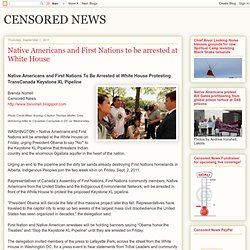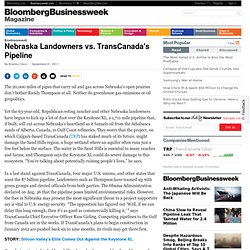

Tar Sands Basics. Map of US Refineries and Pipelines. Tar Sands Pipeline Plan Renews Energy vs. Environment Debate. JEFFREY BROWN: Next: a friendly and safe new source of oil for the U.S. or an environmental disaster waiting to happen?

The tar sands of Alberta, in western Canada, are today considered one of the largest oil reserves in the world, a source of crude petroleum known as bitumen. But the extraction of oil there has come with concerns about the environmental impact. And now those concerns have exploded with a plan by the Calgary-based company TransCanada to build a massive pipeline to carry that crude oil deep into the U.S. The proposed Keystone X.L. pipeline would run 1,700 miles through Montana, South Dakota, Nebraska, Kansas and Oklahoma on its way to refineries in Texas.
It’s projected to cost $7 billion and carry an estimated 800,000 barrels of oil a day. Activists are now in the midst of a two-week protest at the White House. A final decision to allow or reject the pipeline will come from Secretary of State Clinton and ultimately President Obama. Bill McKibben, why these protests? So… Keystone_XL_Pipeline_Not_Needed_2010-05-07.pdf (application/pdf Object) Native Americans and First Nations to be arrested at White House. Native Americans and First Nations To Be Arrested at White House Protesting TransCanada Keystone XL Pipeline Brenda Norrell Censored Photo Credit Milan Ilnyckyj: Clayton Thomas Muller, Cree, delivering letter to Canadian Consulate in DC on Wednesday.

WASHINGTON -- Native Americans and First Nations will be arrested at the White House on Friday, urging President Obama to say "No"' to the Keystone XL Pipeline that threatens Indian country and the enormous Ogallala aquifer in the heart of the nation. Urging an end to the pipeline and the dirty tar sands already destroying First Nations homelands in Alberta, Indigenous Peoples join the two week sit-in on Friday, Sept. 2, 2011. Representatives of Canada’s Assembly of First Nations, First Nations community members, Native Americans from the United States and the Indigenous Environmental Network, will be arrested in front of the White House to protest the proposed Keystone XL pipeline. Tar Sands Action. Nebraska Landowners vs. TransCanada's Pipeline. The 20,000 miles of pipes that carry oil and gas across Nebraska’s open prairies don’t bother Randy Thompson at all.

Neither do greenhouse gas emissions or oil geopolitics. Yet the 63-year-old, Republican-voting rancher and other Nebraska landowners have begun to kick up a lot of dust over the Keystone XL, a 1,711-mile pipeline that, if built, will cut across Nebraska’s heartland as it funnels oil from the Athabasca sands of Alberta, Canada, to Gulf Coast refineries. They worry that the project, on which Calgary-based TransCanada (TRP) has staked much of its future, might damage the Sand Hills region, a huge wetland where an aquifer often runs just a few feet below the surface.
The water in the Sand Hills is essential to many ranches and farms, and Thompson says the Keystone XL could do severe damage to this ecosystem. “You’re talking about potentially ruining people’s lives,” he says. Still, the opposition in Nebraska is digging in. The state’s top three elected officials—U.S. David A. Great Plains Tar Sands Pipelines.